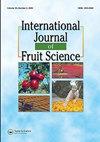Variations of Antioxidant Properties and Enzymes Activities during the Whole Fruit Fermentation of Two Kiwifruit (Actinidia chinenesis Planch.)
IF 2.5
3区 农林科学
Q2 HORTICULTURE
引用次数: 0
Abstract
ABSTRACT In this study, antioxidant properties and enzymatic activities during fermentation of Kiwifruit from two Actinidia genotypes were evaluated. The samples were evaluated for solid content (SSC), total phenols, superoxide dismutase (SOD) and protease. Antioxidant capacity was determined using four assays: 2,2-diphenyl-1-picrylhydrazyl (DPPH), 2,2’-azimo-bis(3-ethylbenzothiazoline-6-sulfonic acid) (ABTS), hydroxyl radical (HR) scavenging rate and superoxide anion radical (SAR) scavenging rate. In the process of fermentation, the antioxidant and enzyme activities of artificial fermentation kiwifruit products were significantly higher than those of natural fermentation (p < .05). At the end of fermentation, the contents of total phenols and SSC in the fermented products of Hongyang kiwi fermentation (HKF) group and Cuiyu kiwi fermentation (CKF) group were significantly decreased, while the antioxidant properties of DPPH, ABTS, HR and SAR were significantly increased compared with the fresh kiwi (p < .05). In addition, the content of protease and superoxide dismutase was also increased. It was also found that the antioxidant properties and the enzyme activities in the HKF group were higher than those in the CKF group. ABTS and SOD activities were more obvious, which were 1.42 times and 2.22 times of the CKF, respectively. HKF group showed better nutritional properties and biological activities.两种猕猴桃(Actinidia chinenesis Planch.)全果发酵过程中抗氧化特性及酶活性变化
摘要本研究研究了猕猴桃两种猕猴桃属基因型的抗氧化性能和发酵过程中的酶活性。测定样品的固含量(SSC)、总酚、超氧化物歧化酶(SOD)和蛋白酶。采用2,2-二苯基-1-吡啶肼(DPPH)、2,2 ' -偶氮-双(3-乙基苯并噻唑-6-磺酸)(ABTS)、羟基自由基(HR)清除率和超氧阴离子自由基(SAR)清除率四种方法测定抗氧化能力。在发酵过程中,人工发酵猕猴桃制品的抗氧化活性和酶活性显著高于自然发酵猕猴桃制品(p < 0.05)。发酵结束时,红阳猕猴桃发酵(HKF)组和翠鱼猕猴桃发酵(CKF)组发酵产物中总酚和SSC含量显著降低,DPPH、ABTS、HR和SAR抗氧化性能显著高于新鲜猕猴桃(p < 0.05)。蛋白酶和超氧化物歧化酶的含量也有所增加。同时发现,HKF组的抗氧化性能和酶活性均高于CKF组。ABTS和SOD活性更明显,分别是CKF的1.42倍和2.22倍。HKF组表现出较好的营养特性和生物活性。
本文章由计算机程序翻译,如有差异,请以英文原文为准。
求助全文
约1分钟内获得全文
求助全文
来源期刊

International Journal of Fruit Science
Agricultural and Biological Sciences-Agronomy and Crop Science
CiteScore
6.40
自引率
0.00%
发文量
64
审稿时长
10 weeks
期刊介绍:
The International Journal of Fruit Science disseminates results of current research that are immediately applicable to the grower, extension agent, and educator in a useful, legitimate, and scientific format. The focus of the journal is on new technologies and innovative approaches to the management and marketing of all types of fruits. It provides practical and fundamental information necessary for the superior growth and quality of fruit crops.
This journal examines fruit growing from a wide range of aspects, including:
-genetics and breeding
-pruning and training
-entomology, plant pathology, and weed science
-physiology and cultural practices
-marketing and economics
-fruit production, harvesting, and postharvest
 求助内容:
求助内容: 应助结果提醒方式:
应助结果提醒方式:


